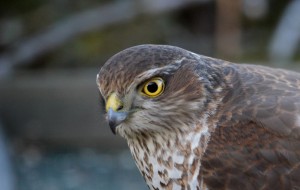 A typical garden scene at this time of the year is with various birds busy around the different feeders before they break up into territories and start nest building. Siskins are busy at the sunflower hearts and look as though they will display at any other birds that comes close. They even display at the much larger goldfinches. The goldfinches, meanwhile, are mainly at the nyjer seed and seldom seem to display even among themselves. Chaffinches, great tits and greenfinches are at the peanuts and, in some gardens, yellowhammers are feeding on seeds on the ground. Then, suddenly, every bird has gone with not a single one in sight. If you are lucky you will see the culprit, a male sparrowhawk, that passes through the garden in seconds, and easy to miss. The small birds will not come back until they see the coast is clear and even then one or two come in with the rest following, sometimes over a long period, and the ritual starts all over again.
A typical garden scene at this time of the year is with various birds busy around the different feeders before they break up into territories and start nest building. Siskins are busy at the sunflower hearts and look as though they will display at any other birds that comes close. They even display at the much larger goldfinches. The goldfinches, meanwhile, are mainly at the nyjer seed and seldom seem to display even among themselves. Chaffinches, great tits and greenfinches are at the peanuts and, in some gardens, yellowhammers are feeding on seeds on the ground. Then, suddenly, every bird has gone with not a single one in sight. If you are lucky you will see the culprit, a male sparrowhawk, that passes through the garden in seconds, and easy to miss. The small birds will not come back until they see the coast is clear and even then one or two come in with the rest following, sometimes over a long period, and the ritual starts all over again.
Many such attacks are not successful but even so it means your garden is likely to be in the sparrowhawk’s territory from now through the summer. Often the sparrowhawk is not successful and sometimes it will sit in a nearby tree looking around as if perplexed as to how it missed so many birds. The bird in the photograph, a young male hatched last year, is doing just that and even looks quizzical! The bird is invariably a male simply because the female is that much larger and will go for larger prey. The male will freely take smaller birds that frequent the garden feeders such as chaffinch, siskin, great tits, goldfinches and greenfinches. In contrast the larger females will take blackbirds and starlings and even birds as big as woodpigeons.
Despite the old nests being still intact, most pairs of sparrowhawks will build new nests each year in the fork of a deciduous tree or near the trunk of a conifer. The nest will now be finished and by the end of April the first eggs will be laid. There are four or five eggs and, like most birds of prey, the incubation starts with the first egg. This is so the chicks will vary in age, and likewise size and strength. This means that if there is a shortage of food then the younger ones do not get enough food and die. In such circumstances the older chicks may kill their smaller siblings and just eat them. A case of survival of the fittest.
Sparrowhawks were much persecuted by gamekeepers although they never suffered quite as much as birds such as the red kite and goshawk, mainly because they were so secretive and difficult to shoot or trap. So the tables showing the “bounties” paid for various birds, including birds of prey, do no show many sparrowhawks. Even so the persecution was not as effective as that of agricultural pesticides up until the 1980s when these chemicals were fazed out. Nowadays, persecution still takes place, illegally, mainly where pheasants and partridges are raised for shooting. In contrast, the sparrowhawk was always much prized in falconry and the male was called a “musket” and the early hand guns used by infantry were named after this. After the sharp decline in the 20th century, there was a dramatic increase and, in many areas, they are now the commonest birds of prey although, perhaps, seldom seen. There are thought to be a round 8,000 to 12,000 pairs breeding in Scotland with the wide range indicating just how secretive they can be.
Tags: highland wildlife
